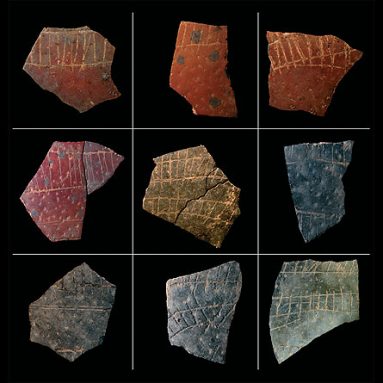Writing on eggshells
Etchings on artifacts suggest that really ancient people used symbols.
From graffiti and wallpaper to the geometric shapes used to decorate buildings, people have been making designs out of patterns for a long time. Designs can be just for looks, or they can be used to communicate a message.
According to a new study, an ancient culture in what is today South Africa scratched on ostrich eggshells to make symbols 60,000 years ago. The researchers say these shells represent some of the earliest evidence yet for people engraving designs.
The eggshells were discovered at the Diepkloof Rock Shelter in South Africa, and over the last few years researchers have collected 270 shell fragments with scratch marks on them. The largest pieces are roughly the size of your thumbnail, and the researchers think that the 270 pieces could have come from about 25 different eggshells.

In a recent study led by Pierre-Jean Texier, researchers say they have identified two patterns in the scratches. The older pattern looks something like a ladder on its side: two parallel lines are connected by smaller lines etched at right angles to the original two. The newer pattern also uses parallel lines with shorter lines crossing them, but sometimes the long lines run together or cross each other.
Each pattern was popular for awhile sometime between 65,000 and 55,000 years ago. Texier is an archaeologist at the University of Bordeaux 1 in Talence, France. An archaeologist is a scientist who studies places where people lived long ago and the artifacts remaining in those places — tools, pottery, or, in this case, eggshells. The goal is to understand the lives and cultures of ancient people.
The eggshells were engraved by the Howiesons Poort culture, African hunter-gatherers. Many of the fragments were found with holes punched in them, which suggests they were parts of containers — in this case, probably vessels used to carry water. The suggestion that these ancient people were able to transport water is very exciting to archaeologists.
“The ability to carry and store water is a breakthrough technological advance, and here we have excellent evidence for it very early,” Curtis Marean told Science News. “Wow!” Marean is an archaeologist at Arizona State University in Tempe.
Archaeologists already knew that this ancient culture — as well as other cultures nearby — carved designs into pieces of clay, but this study shows that the ancient people came back to the same patterns over and over again.
A particular pattern may show ownership: Just as you write your name on your belongings, someone may have scratched his pattern into his water vessel. Texier, who led the study, suggests the patterns may have identified shells that belonged to a particular community.
The ostrich eggshells aren’t the oldest artifacts to emerge from this part of South Africa. Recently, 13 pieces of engraved pigment were removed from the area. (Pigment is a kind of clay often used for coloring.) These pieces are believed to be between 75,000 and 100,000 years old — showing that ancient cultures had already started carving designs by that time.







